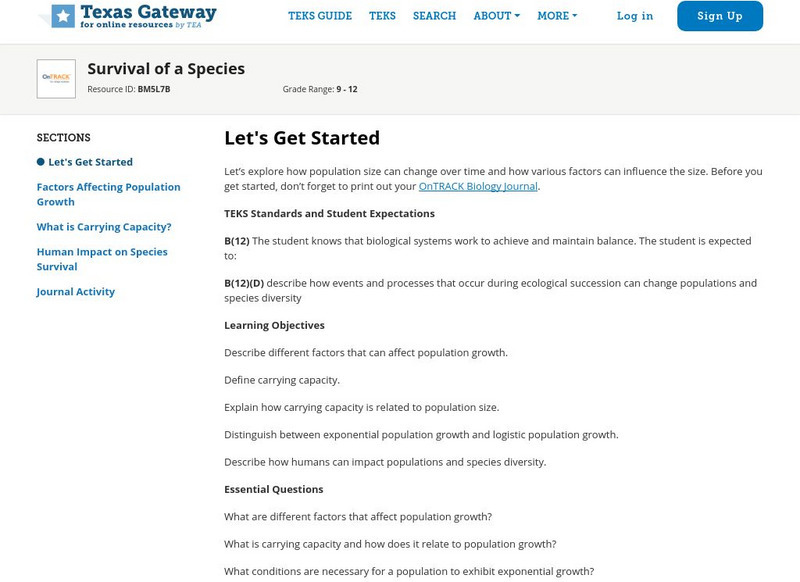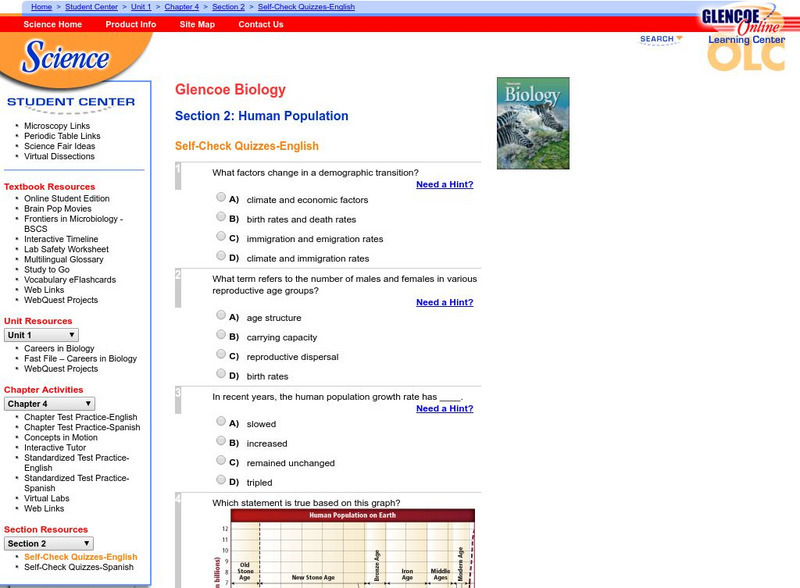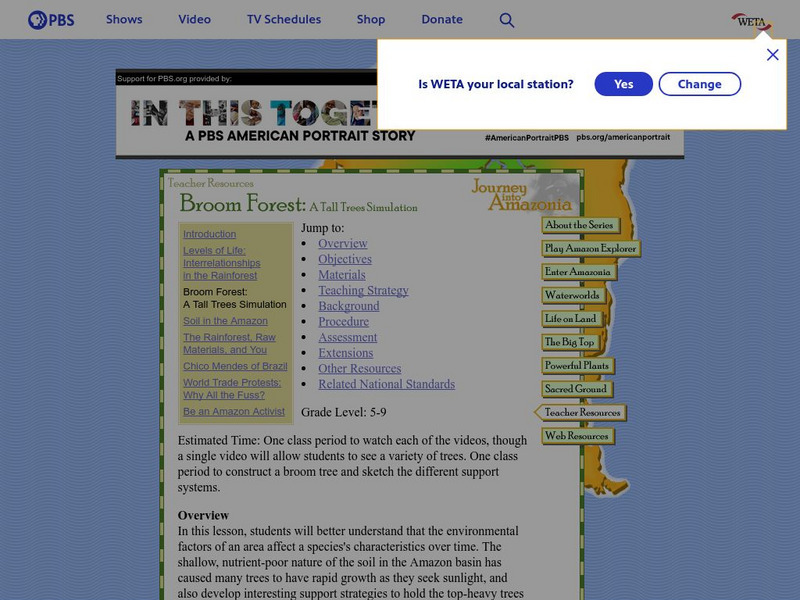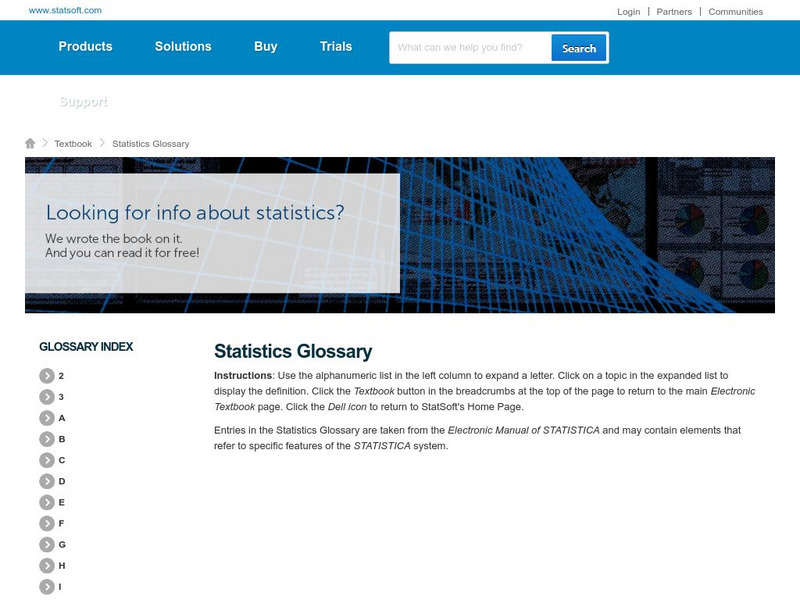The Association of the British Pharmaceutical Industry
Abpi: Population Growth
Students control the environments in four different scenarios to discover how any changes might affect populations. The different simulations include microorganisms, rabbits, foxes, and other organisms.
Oswego City School District
Regents Prep: Ecosystems/communities
Abiotic factors vary in the environment and determining the types and numbers of organisms that exist in that environment. Factors which determine the types and numbers of organisms of a species in an ecosystem are called limiting...
CK-12 Foundation
Ck 12: Earth Science: Population Size
[Free Registration/Login may be required to access all resource tools.] How environmental factors put limits on population sizes.
CK-12 Foundation
Ck 12: Earth Science: Population Size
[Free Registration/Login may be required to access all resource tools.] Looks at how environmental factors put limits on population sizes.
TeachEngineering
Teach Engineering: Designing a Sustainable Guest Village
This lesson introduces students to their task of designing a permanent guest village within the Saguaro National Park. The design must provide a true desert experience to visitors while also emphasizing sustainable design, protection of...
Other
American Statistical Association: Who Sends the Most Text Messages? [Pdf]
In this detailed lesson looking at text messaging behavior, students investigate the sampling distribution for the sample mean to learn what factors affect its shape. They will also be introduced to the Central Limit Theorem.
Texas Education Agency
Texas Gateway: Survival of a Species
Given scenarios, illustrations or descriptions, the student will describe how long-term survival of species is dependent on changing resource bases that are limited.
Other
Smart Motorist: What Causes Car Accidents?
There are four factors that "Contribute to the vast majority of collisions." This detailed website discusses these: "Equipment Failure," "Roadway Design," "Poor Roadway Maintenance," and "Driver Behavior."
Other
Story md.com: Atherosclerosis
Atherosclerosis is a disease in which plaque builds up inside your arteries. Plaque is a sticky substance made up of fat, cholesterol, calcium, and other substances found in the blood. Over time, plaque hardens and narrows your arteries....
Other
Explore Learning: Food Chain Gizmo
In this ecosystem consisting of hawks, snakes, rabbits and grass, the population of each species can be studied as part of a food chain. Disease can be introduced for any species, and the number of animals can be increased or decreased...
Huntington Library
Huntington Library: Garden Lesson Plans: Learning From Leaves [Pdf]
An investigation into how light levels affect leaf adaptations in plants.
Math Notes and Math Tests
Pre Calculus Notes: Polynomial Functions of Higher Degree [Pdf]
The resource discusses polynomial functions of higher degree. Topics examined are infinity, limits, the factor theorem, and the intermediate value theorem.
National Institute of Educational Technologies and Teacher Training (Spain)
Ministerio De Educacion: Los Seres Vivos Y El Medio Ambiente
What is ecology? What is a biome? You will find the answers to these questions in this unit and also learn about the organization of the Biosphere, major Biomes of the earth and the adaptations of living things to limiting factors. It...
Friends of Algonquin Park
Factors Limiting Population Growth of Wolves in Algonquin Park
Information is given on the Eastern Wolf's appearance, migration, food, breeding and predators. Several of the topics are highlighted with video clips. Research questions and answers examine the environmental impact on the wolves in the...
Other
Explore Learning: Effect of Environment on New Life Form
Using the scientific method, control the environmental conditions for a fictional alien organism in order to learn how the organism responds to changes in conditions. Sunlight, water, and temperature can be varied to determine their...
CPALMS
Florida State University Cpalms: Florida Students: Where Have All the Scrub Jays Gone?
Learn how organisms rely on one another but also compete with one another within the same ecosystem.
CK-12 Foundation
Ck 12: Earth Science: Population Size Study Guide
Review information on population size using this study guide.
Other
Jump Cut: Conflict and Contradiction in the Mass Media
The author of this articles explores the evolution of thinking about mass media's role in society, and discusses the positive and negative aspects of mass media, and ways that it can be in conflict with corporations, governments, and...
McGraw Hill
Glencoe Biology: Human Population: Self Check Quiz
Answer five multiple-choice, self-checking questions on human population.
Libre Text
Libre Texts: Physics: Distortion of Space and Time
If the speed of light remains a constant then time and distance change. Oh, it can be confusing! This text will help clear up the confusion. Discussion questions should serve to reinforce comprehension.and exercises
PBS
Pbs Teachers:broom Forest: A Tall Trees Simulation
Explore environmental factors of an area that affect a species' characteristics over time. Construct a "broom" tree, sketch support structures similar to those used by the tall Amazon trees and explain the limitations of such structures.
Other
Explore Learning: Rainfall and Bird Beaks
Explore how environmental conditions affect the adaptation of birds in this simulation. The amount of annual precipitation on an island is controlled by you while you track changes in the thickness of bird beaks over a five-year period....
Other
Stat Soft: Statistics Glossary
Dozens of statistical terms are defined and illustrated in this glossary.
CK-12 Foundation
Ck 12: Biology: Population Growth Patterns
[Free Registration/Login may be required to access all resource tools.] Covers different patterns of population growth.
Other popular searches
- Ecosystem Limiting Factors
- Ecology Limiting Factors
- Population Limiting Factors
- Ecology and Limiting Factors
- Limiting Factors in Population
- Limiting Factors in Ecosystems
- Limiting Factors of Population




















